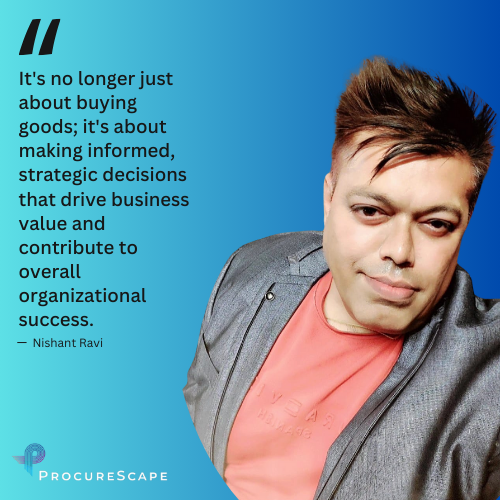Having honed his procurement skills across manufacturing, energy, and mining sectors, Nishant Ravi is a procurement professional who has a passion for driving cost optimization and developing strategic sourcing strategies across diverse industries.
With a firm belief in the power of technology and data analytics to elevate procurement processes and deliver exceptional value to organizations, Nishant is also a content sharing colossus when it comes to all things procurement. As his many LinkedIn followers will confirm.
A great networker and generous with his time we took advantage of a short window in his schedule to get his thoughts on the evolution of procurement and how the function can continue to flex its muscle.
Nishant, how has procurement and the expectations placed upon it changed over time?
Procurement has evolved dramatically. Where it once focused primarily on transactional activities, today’s procurement professionals are expected to be strategic advisors and value creators. This shift is evident in the increased emphasis on:
- Business Case Development: Procurement now plays a key role in building compelling business cases for investments and projects. This involves conducting thorough market research, analyzing costs and benefits, and assessing risks to justify procurement decisions and demonstrate their value to the organization. Know what you are buying!
- Value Analysis: Beyond just focusing on the lowest price, procurement teams are now deeply involved in value analysis. This means understanding the total cost of ownership, evaluating the quality and functionality of goods and services, and identifying opportunities to optimize value throughout the procurement lifecycle. You do not buy stuff, you buy benefits by paying costs(beyond the price)
- Category Knowledge: Modern procurement demands deep category expertise. Professionals need to possess a strong understanding of specific markets, supplier landscapes, and industry trends. This knowledge enables them to develop effective sourcing strategies, negotiate favorable contracts, and manage supplier relationships strategically. Know the external environment if you want to do a SWOT analysis of your Procurement approach.
This evolution has elevated procurement’s role within organizations. It’s no longer just about buying goods; it’s about making informed, strategic decisions that drive business value and contribute to overall organizational success.
What can procurement do better?
Several areas offer opportunities for improvement in procurement. One is data analytics. Manage your Data Supply Chain more effectively, to gain valuable insights into spending patterns, supplier performance, and market trends. This information can be used to make more informed decisions about sourcing, negotiation, and risk management.
Another area for improvement is collaboration. Procurement teams often operate in silos, which can lead to inefficiencies and missed opportunities. Working more closely with other departments, such as finance, marketing, and operations, procurement can create a more streamlined and effective supply chain.A must thing to do when every department has conflicting priorities.
Embracing innovation as much as possible. New technologies, such as artificial intelligence and blockchain, have the potential to revolutionize the procurement process. However, the transition must be smooth and people must be properly and appropriately placed in the RACI Matrix of these digital transformation projects.
A technology is as good as the people who use it.
Procurement has immense potential to add further value. Key areas for improvement include:
- Data Analytics: Harnessing the power of data analytics is crucial. By effectively analyzing spending patterns, supplier performance, and market trends, procurement can unlock valuable insights for informed decision-making in sourcing, negotiation, and risk mitigation.
- Collaboration: Breaking down silos and fostering collaboration is essential. Procurement should actively engage with other departments like finance, marketing, and operations to streamline the supply chain and optimize processes. This includes:
- Buyer and Supplier Joint Exercises: To effectively manage costs, procurement should initiate joint exercises with suppliers. These collaborative workshops can focus on identifying cost drivers, exploring innovative cost-saving solutions, and optimizing processes throughout the supply chain. This fosters a partnership approach where both parties benefit from shared knowledge and mutual gains.
- Embracing Innovation: Staying ahead of the curve requires embracing innovation. Procurement teams should actively explore and adopt new technologies
What have been the biggest changes to procurement during your career?
The biggest change I’ve seen in procurement is the increased focus on strategic sourcing. In the past, procurement was primarily concerned with getting the best price on goods and services. Today, it’s about finding suppliers who can provide the best value, not just the lowest cost. This requires a more holistic approach to supplier selection, taking into account factors such as quality, sustainability, and innovation.
Another major change is the rise of technology. Procurement software has become increasingly sophisticated, automating many tasks and providing valuable data insights. This has allowed procurement teams to become more efficient and effective.
Procurement has become more globalized. Companies are now sourcing goods and services from all over the world, which presents both challenges and opportunities. Procurement teams need to be able to navigate different cultures, regulations, and languages to ensure that they are getting the best possible deals. This also means gathering accurate data on cost drivers (offshore Vs Inshore).

